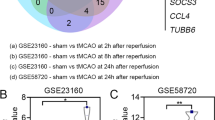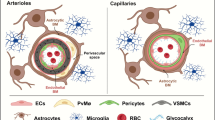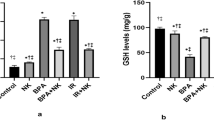Abstract
Hepatic encephalopathy (HE) is a neurologic disease associated with hepatic dysfunction. Astroglial and neuronal alterations have been described in the basal ganglia in HE. Our study was performed to determine whether such alterations are mediated by nitric oxide (NO), by using an experimental model of HE (portacaval anastomosis [PCA]). The expression of the NO synthases (nNOS and iNOS) and the production of nitrotyrosine (NT) were evaluated in the striatum of rats exposed to PCA for 1 and 6 months. The expression of nNOS in the striatal neurons of PCA rats was increased compared to controls. nNOS expression was also detectable in astrocytes after 6 months of exposure to PCA. Whereas astroglial cells in the normal striatum showed no iNOS expression, iNOS was expressed in the astrocytes of PCA brains, mainly in perivascular processes at 6 months PCA exposure (demonstrated by colocalization with GFAP). The increased expression of both the nNOS and iNOS isoforms in PCA rats might indicate a critical role for NO in the pathomechanism of HE. To study the potential cell damage caused by NO, the deposition of NT in PCA-rats was analysed. Nitrotyrosine was detected in neurons although it was mainly seen in the astrocytes of PCA brains, in which double immunolabelling showed NT to be colocalized with GFAP. Thus, the present study shows the induction of iNOS and NT in astrocytes, which increases with the duration of PCA exposure. This suggests that the induced astroglial production of NO during PCA might be one of the main factors contributing to HE.





Similar content being viewed by others
References
Acarin L, Peluffo H, Barbeito L, Castellano B, González B (2005) Astroglial nitration after postnatal excitotoxic damage: correlation with nitric oxide sources, cytoskeletal, apoptotic and antioxidant proteins. J Neurotrauma 22:189–200
Aguilera P, Chánez-Cárdenas ME, Floriano-Sánchez E, Barreda D, Santamaria A, Sanchez-Gonzalez DJ, Pérez-Severiano F, Pedraza-Chaverrí J, Jimenez PD (2007) Time-related changes in constitutive and inducible nitric oxide synthases in the rat striatum in a model of Huntington’s disease. Neurotoxicology 28:1200–1207
Beckman JS (1996) Oxidative damage and tyrosine nitration from peroxynitrite. Chem Res Toxicol 9:836–844
Bizzoco E, Vannucchi M-G, Faussone-Pellegrini M-S (2007) Transient ischemia increases neuronal nitric oxide synthase, argininosuccinate synthetase and argininosuccinate lyase co-expression in rat striatal neurons. Exp Neurol 204:252–259
Bogdanov MB, Wurtman RJ (1997) Possible involvement of nitric oxide in NMDA-induced glutamate release in the rat striatum: an in vivo microdialysis study. Neurosci Lett 221:197–201
Bolaños JP, Almeida A, Stewart V, Peuchen S, Land JM, Clark JB, Heales SJ (1997) Nitric oxide-mediated mitocondrial damage in the brain: mechanisms and implications for neurodegenerative disease. J Neurochem 68:2227–2240
Brahmachari S, Fung YK, Pahan K (2006) Induction of glial fibrillary acidic protein expression in astrocytes by nitric oxide. J Neurosci 26:4930–4939
Butterworth RF (1993) Portal-systemic encephalopathy: a disorder of neuron-astrocytic metabolic trafficking. Dev Neurosci 15:313–319
Butterworth RF (2001) Neurotransmitter dysfunction in hepatic encephalopathy: new approaches and new findings. Metab Brain Dis 16:55–65
Calabresi P, Centonze D, Gubellini P, Marfia GA, Pisani A, Sancesario G, Bernardi G (2000) Synaptic transmission in the striatum: from plasticity to neurodegeneration. Prog Neurobiol 61:231–265
Catania MV, Aronica E, Yankaya B, Troost D (2001) Increased expression of neuronal nitric oxide synthase spliced variants in reactive astrocytes of amyotrophic lateral sclerosis human spinal cord. J Neurosci 21:RC148
Colasanti M, Suzuki H (2000) The dual personality of NO. TIPS 21:249–252
Dawson DL, Dawson TM (1998) Nitric oxide in neurodegeneration. Prog Brain Res 118:215–229
Diemer NH, Klee J, Schröder H, Klinken L (1977) Glial and nerve changes in rats with porto-caval anastomosis. Acta Neuropathol 39:59–68
Divac I, Fonnum F, Storm-Mathisen J (1977) High affinity uptake of glutamate in terminals of corticostriatal axons. Nature (London) 266:377–378
Doyle CA, Slater P (1997) Localization of neuronal and endothelial nitric oxide synthase isoforms in human hippocampus. Neuroscience 76:387–395
Eliasson MJ, Huang Z, Ferrante RJ, Sasamata M, Molliver ME, Snyder SH, Moskowitz MA (1999) Neuronal nitric oxide synthase activation and peroxinitrite formation in ischemic stroke linked to neural damage. J Neurosci 19:5910–5918
Endoh M, Maiese K, Wagner J (1994) Expression of the inducible form of nitric oxide synthase by reactive astrocytes after transient global ischemia. Brain Res 651:92–100
Ezquer ME, Valdez SR, Seltzer AM (2006) Inflammatory responses of the substantia nigra after acute hypoxia in neonatal rats. Exp Neurol 197:391–398
Gahm C, Holmin S, Wiklund PN, Brundin L, Mathiesen T (2006) Neuroprotection by selective inhibition of inducible nitric oxide synthase after experimental brain contusion. J Neurotrauma 23:1343–1354
Graybiel AM (1995) The basal ganglia. Trends Neurosci 18:60–62
Häussinger D, Schliess F (2005) Astrocyte swelling and protein tyrosine nitration in hepatic encephalopathy. Neurochem Int 47:64–70
Iadecola C, Zhang F, Xu S, Casey R, Rosse ME (1995) Inducible nitric oxide synthase gene expression in brain following cerebral ischemia. J Cereb Blood Flow Metab 15:378–384
Inoue E, Hori S, Narumi Y, Fujita M, Kuriyama K, Kadota T, Kuroda C (1991) Portal-systemic encephalopathy: presence of basal ganglia lesions with high signal intensity on MR images. Radiology 179:551–555
Ischiropoulos H, Zhu L, Chen J, Tsai M, Martin JC, Smith CD, Beckman JS (1992) Peroxynitrite-mediated tyrosine nitration catalyzed by superoxide dismutase. Arch Biochem Biophys 298:431–437
Iwase K, Iyama K, Akagi K, Yano S, Fukunaga K, Miyamoto E, Mori M, Takiguchi M (1998) Precise distribution of neuronal nitric oxide synthase mRNA in the rat brain revealed by non-radioisotopic in situ hybridization. Brain Res Mol Brain Res 53:1–12
Iwase K, Miyanaka K, Shimizu A, Nagasaki A, Gotoh T, Mori M, Takiguchi M (2000) Induction of endothelial nitric oxide synthase in rat brain astrocytes by systemic lipopolysaccharide treatment. J Biol Chem 275:11929–11933
Layrargues GP (2001) Movement dysfunction and hepatic encephalopathy. Metab Brain Dis 16:27–35
Lüth H-J, Holzer M, Gärtner U, Staufenbiel M, Arendt T (2001) Expression of endothelial and inducible NOS-isoforms is increased in Alzheimer’s disease, in APP 23 transgenic mice and after experimental brain lesion in rat: evidence for an induction by amyloid pathology. Brain Res 913:57–67
Lüth H-J, Münch G, Arendt T (2002) Aberrant expression of NOS isoforms in Alzheimer’s disease is structurally related to nitrotyrosine formation. Brain Res 953:135–143
Mitchell IJ, Cooper AJ, Griffiths MR (1999) The selective vulnerability of striatopallidal neurons. Prog Neurobiol 59:691–719
Murphy S (2000) Production of nitric oxide by glial cells: regulation and potential roles in the CNS. Glia 29:1–14
Nathan C, Calingasan N, Nezezon J, Ding A, Lucia MS, La Perle K, Fuortes M, Lin M, Ehrt S, Kwon NS, Chen J, Vodovotz Y, Kipiani K, Beal MF (2005) Protection from Alzheimer’s-like disease in the mouse by genetic ablation of inducible nitric oxide synthase. J Exp Med 202:1163–1169
Norenberg MD (1987) The role of astrocytes in hepatic encephalopathy. Neurochem Pathol 6:13–33
Norenberg MD (1998) Astroglial dysfunction in hepatic encephalopathy. Metab Brain Dis 13:319–335
Norenberg MD, Lapham LW, Nichols FA, May AG (1974) An experimental model for the study of hepatic encephalopathy. Arch Neurol 31:106–109
Pekny M, Nilsson M (2005) Astrocyte activation and reactive gliosis. Glia 50:427–434
Peterson C, Giguère JF, Cotman CW, Butterworth RF (1990) Selective loss of NMDA-sensitive 3H-glutamate binding sites in rat brain following portacaval anastomosis. J Neurochem 55:386–390
Rao VLR, Audet RM, Butterworth RF (1995) Increased nitric oxide synthase activities and L-[3H]arginine uptake in brain following portacaval anastomosis. J Neurochem 65:677–678
Rao VLR, Audet RM, Butterworth RF (1997) Increased neuronal nitric oxide synthase expression in brain following portacaval anastomosis. Brain Res 765:169–172
Rodrigo J, Springall DR, Uttenthal O, Bentura ML, Abadia-Molina F, Riveros-Moreno V, Martinez-Murillo R, Polak JM, Moncada S (1994) Localization of nitric oxide synthase in the adult rat brain. Philos Trans R Soc Lond B Biol Sci 345:175–221
Rodrigo J, Fernández-Vizarra P, Castro-Blanco S, Bentura ML, Nieto M, Gómez-Isla T, Martinez-Murillo R, Martinez A, Serrano J, Fernández AP (2004) Nitric oxide in the cerebral cortex of amyloid-precursor protein (SW) Tg2576 transgenic mice. Neuroscience 128:73–89
Rodrigo R, Erceg S, Rodriguez-Diaz J, Saez-Valero J, Piedrafita B, Suárez I, Felipo V (2007) Glutamate-induced activation of nitric oxide synthase is impaired in cerebral cortex in vivo in rats with chronic liver failure. J Neurochem 102:51–64
Rothstein JD, Dykes-Hoberg M, Pardo CA, Bristol LA, Jin L, Kuncl RW, Kanai Y, Hediger MA, Wang Y, Schielke JP, Welty DF (1996) Knockout of glutamate transporters reveals a major role for astroglial transport in excitotoxicity and clearance of glutamate. Neuron 16:675–686
Schliess F, Görg B, Fischer R, Desjardins P, Bidmon HJ, Herrmann A, Butterworth RF, Zilles K, Häussinger D (2002) Ammonia induces MK-801-sensitive nitration and phosphorylation of protein tyrosine residues in rat astrocytes. FASEB J 16:739–741
Sergeeva OA, Schulz D, Doreulee N, Ponomarenko AA, Selbach O, Borsch E, Kircheis G, Huston JP, Häussinger D, Haas HL (2005) Deficits in cortico-striatal synaptic plasticity and behavioral habituation in rats with portacaval anastomosis. Neuroscience 134:1091–1098
Spahr L, Burkhard PR, Grotzsch H, Hadengue A (2002) Clinical significance of basal ganglia alterations at brain MRI and 1H MRS in cirrhosis and role in the pathogenesis of hepatic encephalopathy. Metab Brain Dis 17:399–413
Suárez I, Bodega G, Fernández B (2000) Modulation of glutamate transporters (GLAST, GLT-1 and EAAC1) in the rat cerebellum following portocaval anastomosis. Brain Res 859:293–302
Suárez I, Bodega G, Arilla E, Felipo V, Fernández B (2006) The expression of nNOS, iNOS and nitrotyrosine is increased in the rat cerebral cortex in experimental hepatic encephalopathy. Neuropathol Appl Neurobiol 32:594–604
Torreilles F, Salman-Tabcheh S, Guerin MC, Torreilles J (1999) Neurodegenerative disorders: the role of peroxynitrite. Brain Res Rev 30:153–163
Wang L-P, Cheung G, Kronenberg G, Gertz K, Ji S, Kempermann G, Endres M, Kettenmann H (2008) Mild brain ischemia induces unique physiological properties in striatal astrocytes. Glia 56:925–934
Weissenborn K, Kolbe H (1998) The basal ganglia and portal-systemic encephalopathy. Metab Brain Dis 13:261–272
Wu W, Liuzzi FJ, Schinco FP, Depto AS, Li Y, Mong JA, Dawson TM, Snyder SH (1994) Neuronal nitric oxide synthase is induced in spinal cord neurones by traumatic injury. Neuroscience 61:719–726
Zhao G, Flavin MP (2000) Differential sensitivity of rat hippocampal and cortical astrocytes to oxygen-glucose deprivation injury. Neurosci Lett 285:177–180
Zhao X, Haensel C, Araki E, Ross ME, Iadecola C (2000) Gene-dosing effect and persistence of reduction in ischemic brain injury in mice lacking inducible nitric oxide synthase. Brain Res 872:215–218
Acknowledgements
We are grateful to Adrian Burton for reviewing the English version of the manuscript. This work was partially supported by a grant from the Spanish Ministry of Health (G03/155).
Author information
Authors and Affiliations
Corresponding author
Rights and permissions
About this article
Cite this article
Suárez, I., Bodega, G., Rubio, M. et al. Induction of NOS and nitrotyrosine expression in the rat striatum following experimental hepatic encephalopathy. Metab Brain Dis 24, 395–408 (2009). https://doi.org/10.1007/s11011-009-9154-5
Received:
Accepted:
Published:
Issue Date:
DOI: https://doi.org/10.1007/s11011-009-9154-5




